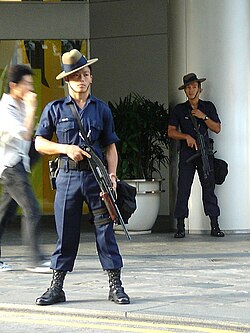
Brigade of Gurkhas is the collective name which refers to all the units in the British Army that are composed of Nepalese Gurkha soldiers. The brigade draws its heritage from Gurkha units that originally served in the British Indian Army prior to Indian independence, and prior to that served for the East India Company. The brigade includes infantry, engineering, signal, logistic and training and support units. They are known for their khukuri, a distinctive heavy knife with a curved blade, and have a reputation for being fierce and brave soldiers.
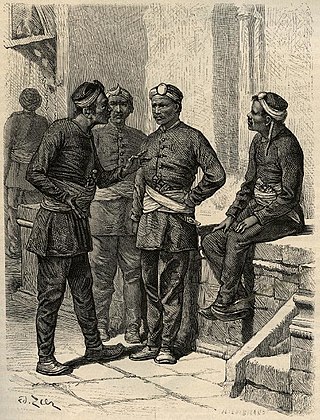
The Gurkhas or Gorkhas, with the endonym Gorkhali, are soldiers native to the Indian subcontinent, chiefly residing within Nepal and some parts of North India.

Pulau Tekong, also known colloquially as Tekong or Tekong Island, is the second-largest of Singapore's outlying islands after Jurong Island. Tekong is located off Singapore's northeastern coast, east of Pulau Ubin. Since the 1990s, the island has been used by the Singapore Armed Forces (SAF) and is generally restricted from public access. Transport to the island for permitted persons is via the SAF Changi Ferry Terminal at Changi Beach.
Gurkhas are soldiers from Nepal.

The Singapore Armed Forces (SAF) are the military of the Republic of Singapore, responsible for protecting and defending the security interests and the sovereignty of the country. A component of the Ministry of Defence (MINDEF), the armed forces have four service branches: the Army, Navy, Air Force, and Digital and Intelligence Service. An integrated force, it is one of the most capable, robust, technologically sophisticated and powerful militaries in the Southeast Asia region. The SAF is headed by the chief of defence force, appointed by the President, on the advice of the Cabinet.

The Royal Gurkha Rifles (RGR) is a rifle regiment of the British Army, forming part of the Brigade of Gurkhas. Unlike other regiments in the British Army, RGR soldiers are recruited from Nepal, which is neither a dependent territory of the United Kingdom nor a member of the Commonwealth.
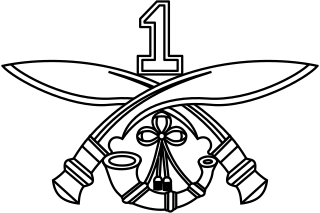
1st Gorkha Rifles (The Malaun Regiment), often referred to as the 1st Gorkha Rifles, or 1 GR in abbreviation, is the most senior Gorkha Infantry regiment of the Indian Army, comprising Gurkha soldiers of Indian Gorkha or Nepalese nationality, especially Magars and Gurungs, hill tribes of Nepal. It was originally formed as part of the East India Company's Bengal Army in 1815, later adopting the title of the 1st King George V's Own Gurkha Rifles (The Malaun Regiment), however, in 1947, following the partition of India, it was transferred to the Indian Army and in 1950 when India became a Republic, it was redesignated as 1st Gorkha Rifles (The Malaun Regiment). The regiment has a long history and has participated in many conflicts, including many of the colonial conflicts prior to Indian independence, as well as the First and Second World Wars. Since 1947 the regiment has also participated in a number of campaigns against Pakistan in 1965 and 1971 as well as undertaking peacekeeping duties as part of the United Nations.

The 3rd Gorkha Rifles or Third Gorkha Rifles, abbreviated as 3 GR is an Indian Army infantry regiment. It was originally a Gurkha regiment of the British Indian Army formed in 1815. This regiment recruit mainly Magars and Gurung tribes. They were present at a number of actions and wars including the siege of Delhi in 1857 to the First and Second World Wars. After the Partition of India in 1947 the regiment was one of the six Gorkha regiments transferred to the Indian Army as part of the Tripartite Agreement signed between India, Nepal and Britain at the time of Indian independence. Prior to independence, the regiment was known as the 3rd Queen Alexandra's Own Gurkha Rifles. In 1950 the regiment's title was changed to 3rd Gorkha Rifles. Since 1947 the regiment has participated in a number of conflicts including the 1947 and 1971 wars against Pakistan.

The 11th Gorkha Rifles is a Gorkha regiment of the Indian Army that was re-raised after independence. The regiment consists of primarily the Kirant Tribes Rai, Limbu, Yakkha, Sunuwar of Eastern Nepal, Darjeeling, Kalimpong, Dooars of West Bengal, Sikkim and other parts of Northeast India. Though it is considered to be the youngest of the Gorkha regiments its lineage is as long as those of the 7th Gurkha Rifles and 10th Gurkha Rifles.

The 4th Gorkha Rifles or the Fourth Gorkha Rifles, abbreviated as 4 GR, is an infantry regiment of the Indian Army comprising Gurkha soldiers of Indian Gorkha or Nepalese nationality, especially Magars and Gurungs hill tribes of Nepal. The Fourth Gorkha Rifles has five infantry battalions. The regiment was raised in 1857 as part of the British Indian Army. In 1947, after India's independence, the Fourth Gurkha Rifles became part of the Indian Army as the Fourth Gorkha Rifles.
The Tripartite Agreement between the United Kingdom, India and Nepal is a treaty signed in 1947 concerning the rights of Gurkhas recruited in military services of United Kingdom and India. This agreement does not apply to Gurkhas employed in the Nepalese Army. Under the agreement, six of the ten Gurkha regiments remained as part of the Indian Army, while the remaining four joined the British Army. As of 2020, India has 39 Gorkha battalions serving in 7 Gorkha regiments. Those transferred to the British Army were posted to other remaining British colonies. In Malaya and Singapore, their presence was required in the Malayan Emergency, and they were to replace the Sikh unit in Singapore which reverted to the Indian Army on Indian independence. Those units in Malaya and Singapore, after these British colonies gained independence, are still part of Brunei and Singapore armed forces respectively.

Singapore maintains an active conscription system in accordance with the regulations set by the Government of Singapore, known as National Service (NS). This requires all qualified male Singaporean citizens and second-generation permanent residents to serve a period of active duty military service in the uniformed services.

The Basic Military Training Centre (BMTC) is a military training facility of the Singapore Armed Forces (SAF). It comprises five schools organised into three camps, of which two are based on Pulau Tekong, an island off the northeast coast of mainland Singapore, while the third camp is in Kranji in northwest Singapore. As its name indicates, it provides basic military training for the majority of recruits enlisted in the SAF.

The Nepalese Army or Gorkha Army is the armed military Land warfare force of Nepal and a major component of the Military of Nepal.
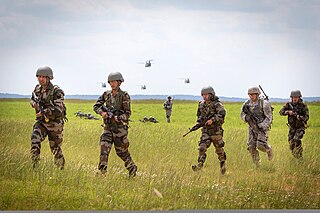
At the time of Indian Independence in 1947, as per the terms of the Britain–India–Nepal Tripartite Agreement, six Gorkha regiments, formerly part of the British Indian Army, became part of the Indian Army and have served ever since. The troops are mainly from ethnic Gurkha communities of Nepal. A seventh Gorkha Rifles regiment was re-raised in the Indian Army after Independence to accommodate Gorkha soldiers of the 7th Gurkha Rifles and the 10th Gurkha Rifles who chose not to transfer to the British Army.

The Royal Brunei Armed Forces (RBAF) is the military of the sultanate nation of Brunei Darussalam. In addition to the Royal Brunei Armed Forces, Brunei also hosts bases for the British Army and the Singapore Armed Forces.

The Royal Malaysia Police trace their existence to the Malacca Sultanate in the 1400s and developed through administration by the Portuguese, the Dutch, modernization by the British beginning in the early 1800s, and the era of Malaysian independence.
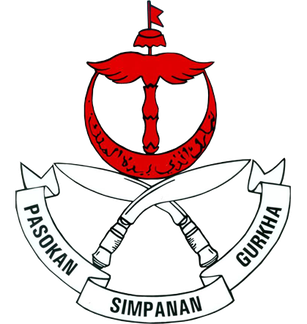
The Gurkha Security Unit(GSU), formerly known as Gurkha Reserve Unit (GRU) and in Malay as Pasukan Simpanan Gurkha (PSG), also referred to as the Royal Brunei Gurkha Reserve Unit, is a Nepalese special elite guard force and royal guard in Brunei.
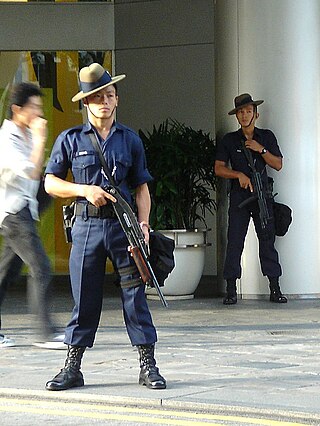
There is a large community of Nepalese in Singapore, consisting mostly of Gurkhas recruited from Nepal and their families.
